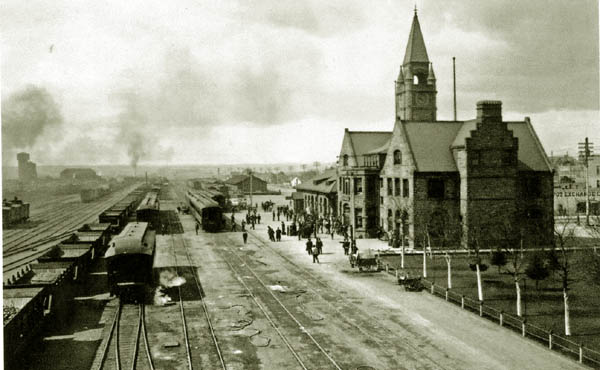
Union Pacific passenger platform looking west from the viaduct, 1906.
As may be observed in the above and next photos, initially there were no sheds to protect passengers from the elements.
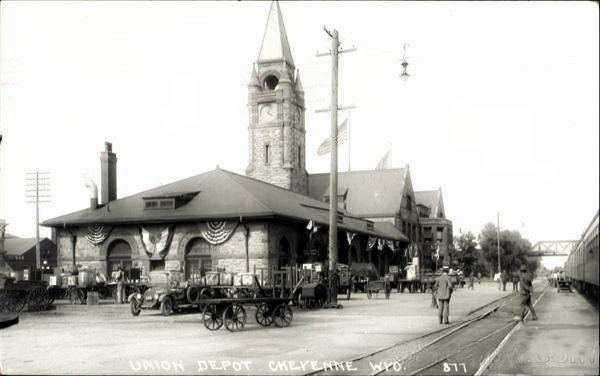
Union Pacific passenger platform looking east toward the viaduct,approx. 1908.
Passengers boarding trains on tracks 2 and 3 were required to walk across tracks to board.
The period from about 1890 to about 1916 has been regarded as the "Golden Age" of American passenger
railroads. The golden age was reflected in improvements to passenger stations such as Cheyenne's. By 1916, American railroads reached their peak in number
of miles of tracks. There then began a slow at first and later a more rapid decline in passenger
trains. The decline was due to a number of factors: (1) The nationalization of railroads during the Wilson Administration using World War I as an
excuse. On December 26, 1917, President Wilson executed a decree taking over the railroads,
"* * *I, WOODROW WILSON, President of the United States, under and by virtue of the powers vested in me * * * do hereby…
take possession and assume control at 12 o'clock noon on the 28th day of December 1917 of each and every system of
transportation… within the boundaries of the continental United States * * *."
Wilson appointed his son-in-law William Gibbs McAdoo as Director General of the railroads with seven
regional dirctors administering different parts of the country. Both freight rates and passenger fares were increased.
The quality of passenger service was reduced. Maintenance was "deferred." Profits were reduced or the railroads under federal control lost money.
At the end of the war, the railroads were returned to their owners, but the lines suffered the effects of the deferred maintainance.
(2)Even after de-nationaliation, the railroads were subjected to increased federal regulation;
(3) Increased use of alternate means of transportation such as motor cars and inter-city busses;
(4) Beginning about 1930 a decrease in the number of passengers due to the "Great Depression;"
(5) As subsequently discussed in the case of Cheyenne, the assumption of passenger service by
Amtrak.
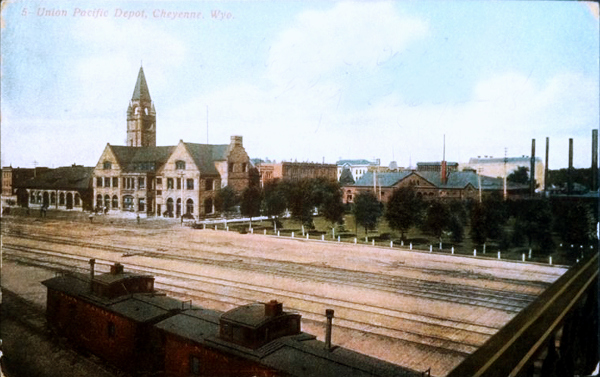
Union Pacific Depot showing
Central Avenue Viaduct on the right and a park to the south of the depot, 1908.
In 1922 following the return of the railroad to the Union Pacific, an extension was added to the east end of the depot balancing out the appearance of the building.
The eastern extension housed a kitchen, lunch counter and dining room.
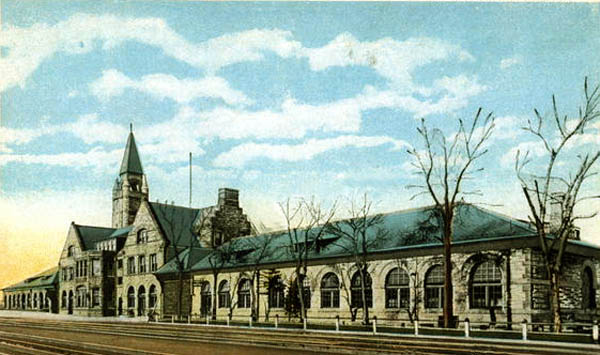
Union Pacific Depot showing
the eastern extension housing the dining facilities. approx. 1922.
The construction of the extension required the removal of a portion of the Park. Further images and discussion of the park is on the
next page.k
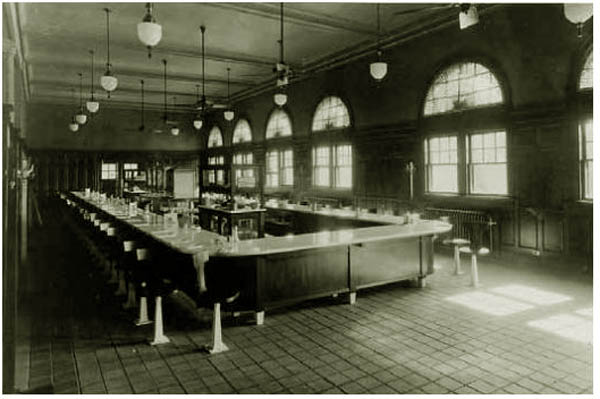
Union Pacific Depot Lunch Counter, photo by
J. E. Stimson, undated.
The adjacent dining room could be used for private parties and meetings such as the Union Pacific "Old Timers' Club.
On Thanksgiving Day, November 21, 1940, writer Ernest Hemingway (1899-1961)
celebrated his marriage to his third wife war correspondent
Martha Gellhorn (1908-1989) in the Dining Room of the Depot. Several weeks before, Hemingway's second wife,
Pauline received an unconested divorce in Florida. At about the same time,
Hemingway's "For the Whom the Bell Tolls," was released. Perhaps as some form of farewell to Pauline,
Hemingway dedicated his new novel to Gellhorn. Although papers such as the
Fresno Bee, November 22, 1940, p. 4, referred to the ceremony as "quiet," as did writer Ruth A. Hawkins, "Unvelievable Happiness and Final Sorrow: The
Hemingway and Pfeiffer Marriage," University of Arkansas Press, p. 229, the ceremoney
was covered by several reporters and photographers including Life Magazine's Robert Capa, an old friend of Hemmingway and
Gellhorn from their days covering the Spanish Civil War when they were holed up in the
Madrid's Florida Hotel. Although the marriage was allegedly a surprize, it was marked by receipt of a congratualatory telegram from
Franklin and Eleanor Roosevelt.
Gellhorn had previously met Hemmingway in Key West's Sloppy Joe's on Duval Square.
Not withstanding that Hemingway was still married, after the end of the Spanish Civil War, the two spent time together in Cuba.
Prior to the wedding,the two spent time together in Sun Valley along with Capa who was on asignment
covering Hemingway for Life Magazine. From the period 1930 to 1939 Hemingway customarially spent some time in the summers in
Wyoming, first near Sheridan in the Big Horns at the Speer-O-Wigwam or the Teepee Lodge, later at the
L Bar T near Cody. Key West in the summer can be a bit muggy and because of
water temperature does not really cool off at night.
The ceremony was officiated by Justice of the Peace Fred A. Stennett (1892-1952).
Stennett had earlier been employed by the Union Pacific in the adjacent
Rail Yards as a switchman. Working in the rail yards is dangerous. In 1930, Stennett fell below a line of
freight cars and had both legs severed. See Greeley Daily Tribune, Nov. 28, 1930. Capa dutifully
took the wedding pictures including one of the Bride and Groom in front of
a bulletin board displaying a map of the Union Pacifc Rail System. A congratulatory telegram was recieved from
President and Mrs. Roosevelt. Accounts of the wedding on the wire services and the New York Times did not fail to
mention Hemmingway's new novel.
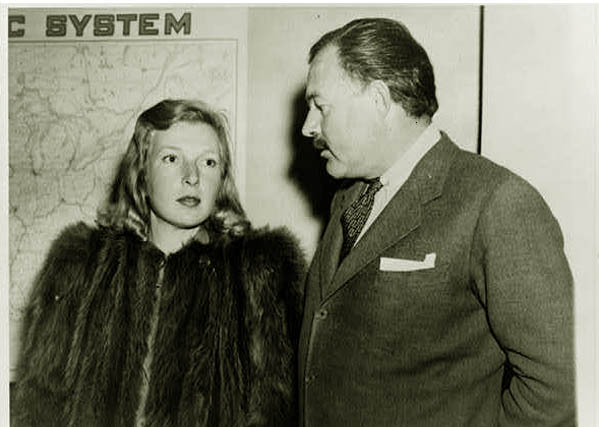
Ernest Hemingway and Martha Gellhorn in front of
map of the Union Pacific System.
Following the wedding ceremony, the couple had a moose venison Thanksgiving Dinner in
the Union Pacfic Dining Room. Justice of the Peace Stinnett in 1945 ran into "legal
difficulties" involving $75.00. He and his wife moved to Colorado. He died in Denver in 1952.
With War on the horizon, Gellhorn resumed her career as a war correspondent. She covered the plight of
residents of the former Czechoslovakia following the annexastion of their homeland by Germany.
During World War II, she covered parts of the D-Day landings. Following the war, she covered the wars in Viet Nam and later the American
removal of Daniel Noriega in Panama. She and Hemingway were divorced in 1945 and she ultimately made her permanent home in
the United Kingdom. With the onset of blindness, she died from the intentional ingestion of poison. In 1961 at Ketchum, Idaho, Hemingway intentionally
shot himself with his favorite shotgun. He had been suffering from an ever increasing depression and paranoia. Hemingway believed that
J. Edgar Hoover was spying on him. At the time, Hemingway was regarded as delusional. Hoover was regarded as an
American hero. Fifty years later, A. E. Hotchner wrote in the New York Times, July 1, 2011:
Decades later, in response to a Freedom of Information petition, the F.B.I. released its Hemingway file. It revealed that beginning in
the 1940s J. Edgar Hoover had placed Ernest under surveillance because he
was suspicious of Ernest’s activities in Cuba. Over the following years, agents filed reports on him and tapped his phones.
The surveillance continued all through his confinement at St. Mary’s Hospital. It is likely that the phone outside
his room was tapped after all.
In the years since, I have tried to reconcile Ernest’s fear of the F.B.I., which I regretfully misjudged,
with the reality of the F.B.I. file. I now believe he truly sensed
the surveillance, and that it substantially contributed to his anguish
and his suicide.
More than forty years later, some fifteen pages of the F.B.I. Hemingway file when released were still redacted.
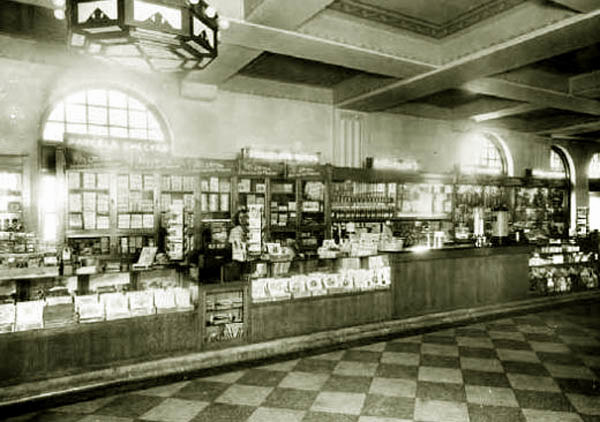
Barkalow Bros. cigar, news and sundries counter, approx.
1930.
Barkalow Bros. headquartered in Omaha since almost the beginning of the Union Pacific maintained Cigar and Souvenier
stands in Union Pacific Stations. Most of the color post cards of Union Pacific properties dating up until about 1940 were published by
Barkaow Bros. They also published souvenir books, playing cards and other items for passengers on the Union Pacific for sale in most stations on the line.
In 1937, the passenger platforms on the southside of the Depot were covered to protect passengers from
rain and snow. Additionally the platforms on the other side of the immediate tracks were re-constructed to permit passengers to reach the
far platforms by way of
"subways, i.e. underground hallways which came up on the desired platform.

East extension of the Depot showing roof
of platform shed and covered walkway connecting lobby to first platform, 1974.
Photo by Jack F. Boucher courtesy of Library of
Congress photo.
As discussed with regard to Green River, a 1904 off-hand comment by railroad President E.H. Harriman led to parks being
created at most if not all of the larger Union Pacific Depots. The one in
Cheyenne was created east of the depot and between the ramps leading to the viaduct and the railway tracks.
The eastern extension and creation of Depot Park and construction of sheds to protect the passengers the major changes in the
Depot. As indicated below both the park and the sheds are now gone.
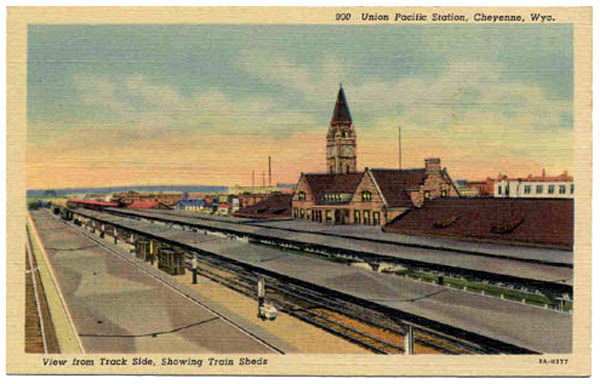
Passenger Sheds looking west from the viaduct, late 1930's.
The stairways from the "subways" are the two structures on the platform in the next photo.
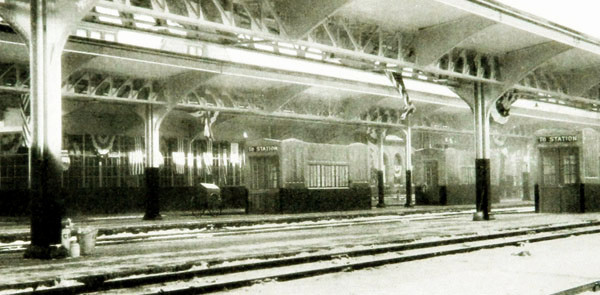
View of passenger platforms under the sheds showing entrance to
the "subways," 1938.
The sheds were removed following assumption of passenger service by
Amtrak. Amtrak moved passenger service from the Union Pacific Depot to a new terminal building [depicted on a
subsequent page] in 1979.
Within the terminal building, there was a cafe and seating on traditional railway wooden benches.
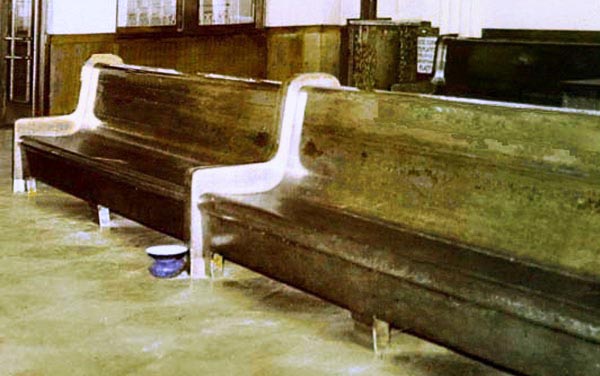
Interior passenger seats with spittoon beneath, undated..
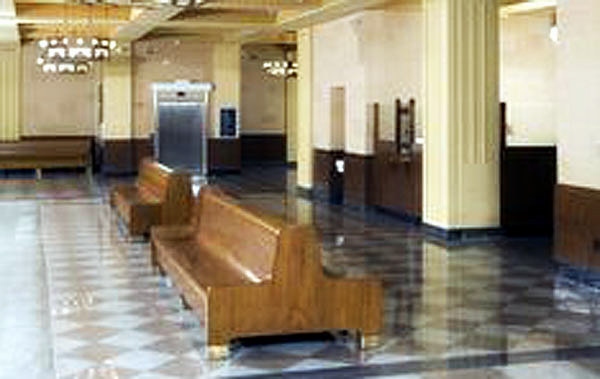
Interior seats.
Next page: Depot Park
|